Programme 1 | Raising Awareness of Artificial Intelligence in the Community
So how did we go about it?
In this programme of public engagement, community members wished to raise awareness of the use of data and Artificial Intelligence in their communities, and ensure their rights were considered and protected. On the programme, we worked with community members from The Tatton Community cafe in Odsall, Salford and also some members of the Inspire Community in Levenshulme, Manchester. The challenge was that they felt they were often left behind and not part of the conversation about how technology was influencing their day-to-day lives. There was a lack of clear understanding of what artificial intelligence was and what it wasn’t. There were concerns about the use of their data (privacy and security) in applications and by artificial intelligence. A number of key themes were explored by community members, including the use of AI and data in various applications (such as healthcare, online banking, monitoring energy and shopping); ensuring that AI is used responsibly, safely and ethically; awareness of how data was used by AI and how to spot deep fakes, misinformation and spam email. Through a series of ideation and co-production sessions, the community members voted to create a video to highlight their concerns about artificial intelligence and raise awareness about its usage and potential impact in their communities. The PEAs involved in this programme include Matthew Thorpe (MMU), Rochelle Taylor (MMU), John Henry (MMU), Ngozi Nneke (University Academy 92), Femi Stevens (Self Employed) and Shobha Gowda (University of Salford and University of Manchester) and members of the project team Keeley Crockett and Sara Linn took part in this programme. Our PEAs had interdisciplinary expertise covering data science, AI, education, business management and leadership and games design. To support this programme, the PEAs and Team members met weekly or fortnightly for an hour to prepare for each session, feedback on allocated tasks and monitor if the project was on track and in budget.
The Tatton – previously known as the Ordsall Cafe Project Ltd is a community charitable organisation based in Ordsall, Salford. Its mission is “to provide an accessible, friendly, and safe social centre to improve the quality of life for the local community”.
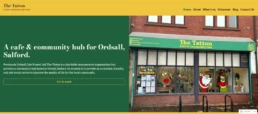
Image Credit: The Tatton – Ordsall Community Cafe & Hub
In this programme of public engagement, two communities came together. As well as the Tatton, members of Inspire – a community in Levenshulme, Manchester also engaged on the project.
Members of the project team had existing relationships with some members of the Inspire and The Tatton community through a project known as The Peoples Panel for Artificial Intelligence. This relationship was built up over 12 months and was important to building trust with wider communities.
Onboarding
The onboarding session aimed to create a shared understanding of AI, build trust and cooperation between researchers and the community, and provide an opportunity to learn through hands-on activities. It also focused on explaining the project’s goals and how participating could benefit the community.
The session emphasised that any co-developed resources would be sustainable, practical, and accessible to other communities. Additionally, it ensured that participants were comfortable with giving informed consent and that proper safeguarding measures were in place.
To prepare for the onboarding sessions, the PEAs worked together to create a presentation to first describe and explain the PEAs in PODS project utilising what they had learn from the PEAs in PODS training Programme.
A challenge was to ensure that everyone was speaking the same language from the perspectives of community language (culture, accessibility etc), research language (i.e. participant information sheet, informed consent etc), and technical language (e.g., data, algorithms, AI, a person’s legal human rights). The PEAs had covered this challenge in the PEAs in PODS training from POD 1, however it is very different when practicing how to do this in a live community environment. For some of the PEAs this was the first time in facilitating a session with community members. It was important that everyone’s expectations were managed, and flexibility and patience were key skills in every session.
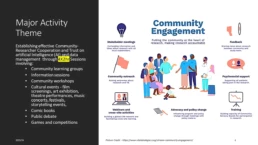
Slide Credit: PEAs
In the original project work plan, each programme of public engagement was to be co-produced in four community sessions which were two hours long. It became very clear as all the projects progressed that this was not going to be sufficient and very much underestimated. In the onboarding session, the PEAs used the original timeline to present to community members a project timeline for this programme of public engagement. However, this significantly evolved over the project journey.
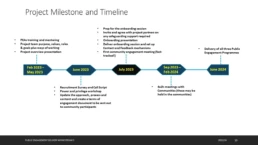
Slide Credit: PEAs
Our original brief was co-created with community members from a series of ideation sessions. In this section we share how we created this brief which was to create a series of educational resources for community members to raise awareness of artificial intelligence. Two ideation sessions were conducted, one a The Tatton and the other at Inspire (see Programme 2). Our PEAs devised a questionnaire based on the insight from the recruitment and onboarding session.
The questions first covered awareness of artificial intelligence (AI), impact on the use of AI in everyday life, discussing a mutual definition of AI plus fears and concerns. The questionnaire then explored AI in the context of apps on phones and the use of data, NHS and healthcare and the use of energy smart meters.
PEAs were paired with community members and asked the questions and recorded the answers. This allowed every member of the community to have their own voice and opinion recorded, without worrying about writing answers. When there was clarity required of the questions that were asked, PEAs could provide this and when community members wanted to explore other areas of AI they could do so.
More importantly, it began building relationships between PEAs and community members. The aim of the first scoping session to shape a brief was to scope out how the community would like us to raise awareness of AI in their communities. At the start of the follow up session, the PEAs first presented a summary of the findings of the questionnaire back to the community.

Image Credits: PEAs
From these insights, community members, PEAS and the MMU team discussed a range of topics and everyone was encouraged to participate under the premise that “there is no bad idea!” and everyone’s voice is equal. The programme challenge was identified and agreed as:
“To raise awareness of the use of data and Artificial Intelligence in communities and ensure the rights of people were considered and protected”.
Community members, PEAs and the project team then discussed a range of different ideas on ways to engage the community and learn about artificial intelligence. Ideas discussed included an AI Sensory Garden, AI – the musical, an AI board game or gaming app, a community companion chatbot, a series of comic books, a citizens ethical AI Charter, AI workbook and in-community workshops.
For each idea the following was considered:
- Does the idea address the challenge?
- Does the idea offer value to the community members both short and longer term?
- Does the community feel that they have had a voice in the ideation and can take part in the design and development of the idea?
- Does the community know what good looks like to them for the idea?
- Can the idea be delivered on budget of £7k?
Community members then voted on their favourite ideas. The two winners were the development of a Peoples Charter for Artificial Intelligence (Programme 1) and a video capturing community members perceptions on artificial intelligence (Programme 2). To summarise the main outcomes from the ideation sessions were
- Educational resources needed to me in different formats (digital and paper based) such as infographics and videos.
- Community members would be involved in co-producing all materials so their voice is heard but they wanted to leave the technical aspects (filming, graphic design) to professionals
- Community members had strong views on the use of Generative AI for helping to support the design process. The Tatton community were completely against and Inspire had mixed feelings.
- Accessibility of educational materials was the key – especially having resources in multiple languages based on the demographics of each community.
At the start of the co-production sessions, the PEAs produced a timeline which was mapped to overall PEAs in Pods project deadlines. As the project began and everyone learned together, these timelines shifted in line with what the community members wanted.
It was important that every session was a safe space for everyone to feel equally valued and share ideas. This was how trust was built. Not all community members attended every session and new community members joined during the process as they had heard from others about the creation of a video and wanted to take part and have a voice.
The co-production sessions would include:
- Design of the content and story-boarding of the public perceptions of artificial intelligence video.
- Co-production of the scripts for the video with community member actors
- Testing of the storyboards and the scripts
- Filming of the video on location at Inspire and the Tatton
- Post-production of the video and community member feedback.
At the end of every session, we also held a reflective circle and asked all participants (Community members, PEAs and MMU Team members) one question to reflect on based on the content of the session.
Co-Production Session 1
Our first co-production session was held jointly with community members from The Tatton (Programme 1) and Inspire (Programme 2). The first session was to narrow the focus on what types of content community members wanted to cover to meet the brief of the Citizens Charter for Artificial Intelligence and the Video resources.
At the start it was very important to establish a mutual understanding of what the community members, the PEAs and the team understood by Artificial Intelligence. We looked at formal definitions including the European Union definition of AI to community members perceptions of AI. It was important to distinguish AI from broader technologies such as automation.
We explored: Where does automation make things better? Where do we still want the option of dealing with a person? Using examples, we explored a number of applications of AI in healthcare, banking , factories – exploring with community members the benefits of the technology along with their concerns.
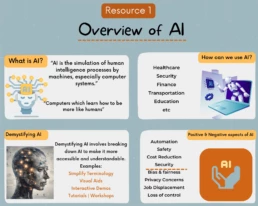
Image Credits: PEAs
To support the development of educational resources, PEAs and the MMU Team had conducted some preliminary research into what educational resources were available that might be of interest to community members. This was found to be very limited. For example, NYU Tandon Center for Responsible AI and Queens Public Library had launched a series comics called “We are AI” aiming to give citizens a primer on AI.
The comic book series was designed to make complex topics on AI “comprehensible to virtually anyone”. Community members thought that whilst a good idea for younger people, this was not useful to people within their communities. During the session, we explored in detail what the content of the education video and infographics would be based on the ideas and suggestions in the ideation sessions. The outcome of the session was initial content for three resources:
Resource 1: What is AI?
- how can we use AI
- demystifying AI
- positive / negative aspects of AI
Resource 2: AI Around Me – different kinds of everyday AI technology such as
- chatbots (in education, in customer service)
- Google maps
- music and streaming (Spotify/Netflix)
- e-payments (banking apps)
- e-tickets (trains)
- self-checkouts (facial recognition for age verification)
- data privacy, consent
Resource 3: Examples of AI (Healthcare, Energy, Banking, Shopping, Education)
- advancements
- data privacy
- explainability
- personalisation
- targeted advertising
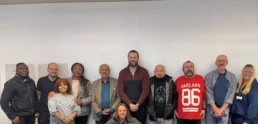
Co-Production Session 2
Session Pre-Planning
Following on from the first co-production session, it was decided that due to time constraints that one educational video would be co-created and co-produced to raise awareness of AI and capture community perceptions. PEAs felt that it was important the video captured as much of the content requested as possible.
It was also agreed that the filming and production of the video be outsourced to a student through the Universities Jobs-4-Students scheme, and this was factored into the £7k budget for this programme. These ideas were to be discussed with community members within the co-production session.
Our second co-production session plan was designed and led by the PEAs.
Session Plan
- Recap on agreed focus of the educational video
- Discuss the style of the video style – Look at some examples of what the video might look like, e.g. live footage, animation, point of view.
- Video content – Share ideas for what the content the video could include focusing on the two key areas: What is AI/demystifying AI and AI in the world around us.
- Story-boarding – Start to storyboard together some ideas for what the video will look like in greater detail. During this activity we will consider the sequence, content and timings of the video
- Debrief and reflection of the session
Focus of the Educational Video
Community members agreed that the video should provide a simple overview of Artificial Intelligence and highlight where AI is being used already by people in their everyday lives, even though they may not know it. The content should demystify AI to make it understandable and accessible to everyone. The video should highlight both the positive and negative aspects of AI.
Video Style
In this activity, PEAs showed to community members a number of different videos of different styles including animation, live action, educational (taught), conversational between two people, interview-based and even AI generated.
Each existing video was listed as an educational AI video, or in the case of the AI generated video, was designed using a prompt created from the focus of the community video. Following discussion, community members preferred live action videos and felt it was important that it contain community members as actors and some of it was filmed in communities.
Story-boarding
PEA, Mathew Thorpe first explained how we would co-produce a series of storyboards for the video. He outlined the different types of camera shots (10 most common types of camera shots in film) that we needed to think about as we created the different storyboards.
Community members and PEAs split into 3 smaller groups and used a storyboard template to capture ideas for the video based upon the agreed focus. This was a fun pen and paper co-production activity which resulted in some great content.

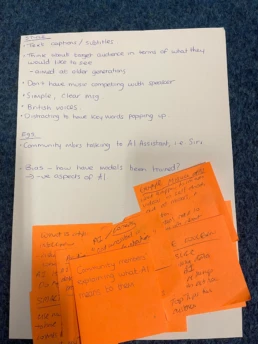
Debrief and reflection.
During this last activity, we discussed what are the must haves and must not have within the video. There was opportunity to discuss any additional details not captured in story-boarding that community members felt needed to be prioritised. It was also a great opportunity to discuss how long should the video be and more importantly how much involvement did they want in the next phase of detailed scripting etc.
We also discussed who the community actors should be. Finally, the community discussed other types of educational resources that could be generated from the video content, such as flyers, posters ad infographics.
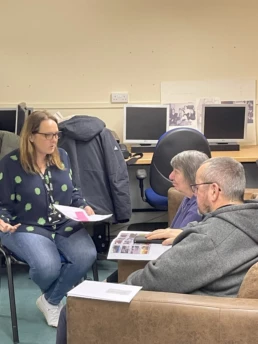
Co-Production Session 3
The aim of this co-production session was to firstly to provide an update to community members on the next steps in producing the video. Secondly to share some initial drafts of script ideas generated from the story-boards and then co-produce these scripts with community members.
During this session, we also informed community members that we were hiring a student under the MMU Jobs4student scheme (Jobs4Students) to film the video on location in communities and to support production of the final video.
In preparation for the session, PEAs and the Team, led by Matt Thorpe, identified the key themes that were required in the video and produced a scaffolding outline of the script and a production schedule. As community members wanted a free flowing video, in places conversational but also with some AI expert knowledge, a series of prompts were developed.
A small sample of these prompts were:
- What does the term AI mean to you?
- Tell me one positive thing AI does or could do for your community? Tell me one concern you have about AI for your community?
- What concerns do you have about increased use of digital services/ Artificial intelligence in health care?
- What concerns do you have about the increase in online banking services?
- What opportunities could Artificial Intelligence offers in terms of employment? How could local communities be supported to ensure they can be up-skilled to work in new jobs that the rise of artificial intelligence will create?
Debrief
Some community members wanted to take part in the video as actors. It was important that at the next co-production session, prior to filming that community members were onboarded to the filming process and gave informed consent.
This required a further ethical amendment to the PEAs in PODs project which included new consent and participant information sheets and additional Privacy notice and consent form specially for Filming, Photography and Video (individual and Group)
In order to prepare for filming in the communities, the PEAs and the Team undertook a lot of planning and preparation. This included, revising the scripts based on the community member feedback, producing a final shot log, drafting and describing each scene of the video. Stock footage was agreed upon and obtained ready for the production phase.
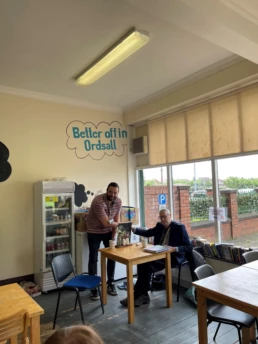
Co-Production Session 4
Filming on Location at Inspire and The Tatton
Filming took place at two locations: Ordsall and Levenshulme in May 2024. Eight community members from both Inspire and The Tatton took part in the filming. Shots outside these locations were requested by community members. The co-produced prompts were used as a starting point, but there was a lot of free-flowing answers by community members.
The atmosphere was very relaxed – it was important that everyone felt comfortable and went at their own pace. The editing and production of the video took 3 weeks and was led by PEA Matt Thorpe with the videographer – Milo Wye. Community members were invited to review the video and check the content, including the closed captions. Edits were then made to the video before it was officially launched.
The output of this Programme was a 10-minute community video about Community Perspectives on Artificial Intelligence. The content of the video and the topics covered were led by the community – this is what matters to people in the age of Artificial Intelligence.
You can view the video here: Community Perspectives on Artificial Intelligence (youtube.com).
The output of this Programme was a 10-minute community video about Community Perspectives on Artificial Intelligence. The content of the video and the topics covered were led by the community – this is what matters to people in the age of Artificial Intelligence.
You can view the video here: Community Perspectives on Artificial Intelligence (youtube.com).
Compensating Communities
Community members were paid £15 per hour for their time using One4All vouchers, which could be spent online or in stores. Refreshments, including lunch for full-day sessions, were provided. Public transport costs were covered, and there was a budget for taxi expenses for people with disabilities who needed them to get to the venue.
Considering Ethics and Consent
In ensuring members of the community were taken care of, and that the data collected and used to to communicate was handled in line with data legislation (e.g. GDPR), MMU and Noisy Cricket worked with Back on Track to protect both the community members who choose to participate and academics in working with them.
MMU and Noisy Cricket ensured:
- Safeguarding and support measures were in place for the people participating in the research should they need support beyond the scope of the project
- Informed consent frameworks were utilised so that community members were clear on what the research involved, any potential benefits and risks as well as the right to withdraw from the research at any time
- Transparency and accountability through conversation and documentation around why the research was being conducted and how it will be used, plus managing expectations around the long-term aims of the project
- Inclusivity through reaching, engaging and balancing the voices of diverse groups, and that information shared and explored is relevant and accessible, as well as facilitation of voices is equitable, especially with marginalised groups
- Rigour in designing ongoing ethical research approaches and methodologies, to respect the social and cultural factors influencing communities, and considering potential biases which might influence the research process
- Reduction of risk through monitored research performance, from adhering to data privacy regulations and minimising unintentional harms to navigating complex situations and addressing power imbalances, to avoid legal issues and support academics in learning and evolving best practice
Exploring Power Dynamics
To help the academics better engage with people affected by homelessness throughout the HI Future Programme, Noisy Cricket held a series of workshops to help them understand how power and privilege shape our views on homelessness and employment.
The PEAs explored:
- Who is accountable and responsible for recruitment and AI ethics in the HI Future program, and who should be consulted and informed about its potential impacts during the Public Engagement Programme.
- Mapping their shared goals, objectives, and values in exploring the project, and any challenges or opportunities that could affect their ability to respond successfully.
- How to address the assumptions and ideas they developed about AI ethics in social mobility recruitment when working with people impacted by homelessness.
- Reflecting on the wants, needs, and hopes of people affected by homelessness in using machine learning to help them find jobs that match their strengths.
- What steps should be taken to make sure the community’s voice is central, trust is built, and value is created for the people involved in the HI Future Program.
Organising and Delivering Workshops
Along with planning agendas, organiSing activities, leading discussions, and capturing key points, the PEAs, MMU, and Noisy Cricket team worked hard to create a warm, welcoming, and safe space where community members felt comfortable participating.
Key actions included:
- Booking meeting spaces in familiar, well-lit locations and offering a range of hot and cold drinks as well as snacks to cater to different dietary needs and preferences. For the HI Future project, this meant reserving a room and arranging catering through Back on Track, which also helped support the charity financially.
- Sharing information about the next session’s time, date, and location at the end of each session. They sent reminders through Back on Track staff and followed up with more details by email or phone, using the communication method chosen by the participants during sign-up. This helped keep attendees informed and encouraged them to attend.
- Giving community members control by regularly asking for consent to take notes or photos at the start of each session. At the end of each workshop, participants were invited to reflect on what they learned and how they felt about the session. By choosing to join in, they gave their permission for their feedback to be recorded.
- Clearly setting expectations at the start of each session helped create a safe environment. This included agreeing on speaking rules (e.g., one person speaks at a time), how participants could signal they wanted to speak, making sure everyone had a chance to contribute, and managing time. The group also discussed what topics were appropriate to talk about in advance.
PEAs needed to stay present, pay close attention to each other and the community members, and ask questions or offer reflections to better understand different viewpoints. It was also important for them to remain flexible and open to any unexpected ideas or new directions that came up during the sessions.